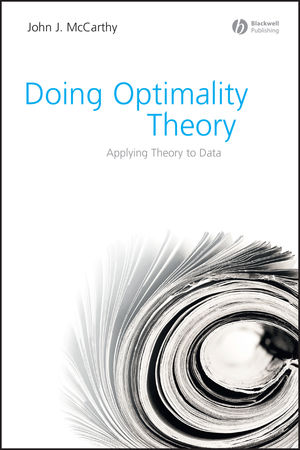|
Textbook
Doing Optimality Theory: Applying Theory to DataISBN: 978-1-4051-5136-8
Paperback
322 pages
May 2008, ©2008, Wiley-Blackwell
 This is a Print-on-Demand title. It will be printed specifically to fill your order. Please allow an additional 10-15 days delivery time. The book is not returnable.
|
||||||
Read This First!.
List of Abbreviations.
1. An Introduction to Optimality Theory.
1.1 How OT Began.
1.2 Why Must Constraints Be Violable?.
1.3 The Nature of Constraints in OT.
1.4 Candidate Sets: OT’s Gen Component.
1.5 Candidate Evaluation: OT’s Eval Component.
1.6 Constraint Activity.
1.7 Differences Between Languages.
1.8 The Version of OT Discussed in This Book.
1.9 Suggestions for Further Reading.
2. How to Construct an Analysis.
2.1 Where to Begin.
2.2 How to Rank Constraints.
2.3 Working through an Analysis in Phonology.
2.4 The Limits of Ranking Arguments.
2.5 Candidates in Ranking Arguments.
2.6 Harmonic Bounding.
2.7 Constraints in Ranking Arguments.
2.8 Inputs in Ranking Arguments.
2.9 Working through an Analysis in Syntax.
2.10 Finding and Fixing Problems in an Analysis.
2.11 Constraint Ranking by Algorithm and Computer.
2.12 The Logic of Constraint Ranking and Its Uses.
3. How to Write Up an Analysis.
3.1 Introduction.
3.2 How to Organize a Paper.
3.3 How to Present an OT analysis.
3.4 The Responsibilities of Good Scholarship.
3.5 How to Write Clearly.
3.6 General Advice about Research Topics.
4. Developing New Constraints.
4.1 Introduction.
4.2 When Is It Necessary to Modify Con?.
4.3 How to Discover a New Constraint.
4.4 How to Define a New Constraint.
4.5 Properties of Markedness Constraints.
4.6 Properties of Faithfulness Constraints.
4.7 Justifying Constraints.
4.8 A Classified List of Common Phonological Markedness Constraints.
5. Language Typology and Universals.
5.1 Factorial Typology.
5.2 Languages Universals and How to Explain Them in OT.
5.3 Investigating the Factorial Typology of a Constraint Set.
5.4 Using Factorial Typology to Test New Constraints.
5.5 Factorial Typology When Con Isn’t Fully Known.
5.6 How to Proceed from Typology to Constraints.
6. Some Current Research Questions.
6.1 Introduction.
6.2 How Does a Language Vary?.
6.3 How Is Language Acquired?.
6.4 Does OT Need Derivations?.
6.5 How Is Ungrammaticality Accounted For?.
6.6 Is Faithfulness Enough?.
Afterword.
References.
Constraint Index.
Language Index.
Subject Index



